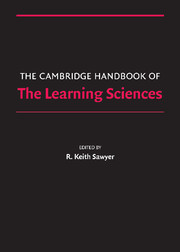Book contents
- Frontmatter
- Contents
- Preface
- Contributors
- 1 Introduction
- PART I FOUNDATIONS
- PART II METHODOLOGIES
- PART III THE NATURE OF KNOWLEDGE
- PART IV MAKING KNOWLEDGE VISIBLE
- PART V LEARNING TOGETHER
- PART VI LEARNING ENVIRONMENTS
- 28 Motivation and Cognitive Engagement in Learning Environments
- 29 Learning as a Cultural Process
- 30 Prospects for Transforming Schools with Technology- Supported Assessment
- 31 Internet Use in Schools
- 32 Teacher Learning Research and the Learning Sciences
- 33 Scaling Up
- 34 Conclusion
- Afterword: After How Comes What
- Epilogue: The Fundamental Issue in the Learning Sciences
- Author Index
- Subject Index
- References
33 - Scaling Up
Evolving Innovations Beyond Ideal Settings to Challenging Contexts of Practice
Published online by Cambridge University Press: 05 June 2012
- Frontmatter
- Contents
- Preface
- Contributors
- 1 Introduction
- PART I FOUNDATIONS
- PART II METHODOLOGIES
- PART III THE NATURE OF KNOWLEDGE
- PART IV MAKING KNOWLEDGE VISIBLE
- PART V LEARNING TOGETHER
- PART VI LEARNING ENVIRONMENTS
- 28 Motivation and Cognitive Engagement in Learning Environments
- 29 Learning as a Cultural Process
- 30 Prospects for Transforming Schools with Technology- Supported Assessment
- 31 Internet Use in Schools
- 32 Teacher Learning Research and the Learning Sciences
- 33 Scaling Up
- 34 Conclusion
- Afterword: After How Comes What
- Epilogue: The Fundamental Issue in the Learning Sciences
- Author Index
- Subject Index
- References
Summary
“Scaling up” involves adapting an innovation that is successful in one setting to be effectively used in a wide range of contexts. In contrast to experiences in other sectors of society, scaling up successful programs has proved very difficult in education (Dede, Honan, & Peters, 2005). Innovations at one fast-food location may easily transfer to every store in that franchise and perhaps to any comparable type of restaurant. However, a new type of teaching strategy that is successful with one practitioner often is difficult to generalize even to other instructors in the same school, let alone to a broad range of practitioners. In general, the more complex the innovation and the wider the range of contexts, the more likely a new practice is to fail the attempt to cross the chasm from its original setting to other sites where its implementation could potentially prove valuable (Moore, 1999). In other words, scalable designs for educational transformation must avoid what Wiske and Perkins (2005) term the “replica trap”: the erroneous strategy of trying to repeat everywhere what worked locally, without taking account of local variations in needs and environments. This involves resolving problems of magnitude (fostering the necessary conditions for change in large numbers of settings with average resources at considerable distances from one another) and variation (diverse and often unfavorable conditions across settings).
In the context of innovations in teaching and curriculum, Coburn (2003) defines scale as encompassing four interrelated dimensions: depth, sustainability, spread, and shift in reform ownership.
Information
- Type
- Chapter
- Information
- The Cambridge Handbook of the Learning Sciences , pp. 551 - 566Publisher: Cambridge University PressPrint publication year: 2005
References
Accessibility standard: Unknown
Why this information is here
This section outlines the accessibility features of this content - including support for screen readers, full keyboard navigation and high-contrast display options. This may not be relevant for you.Accessibility Information
- 10
- Cited by
